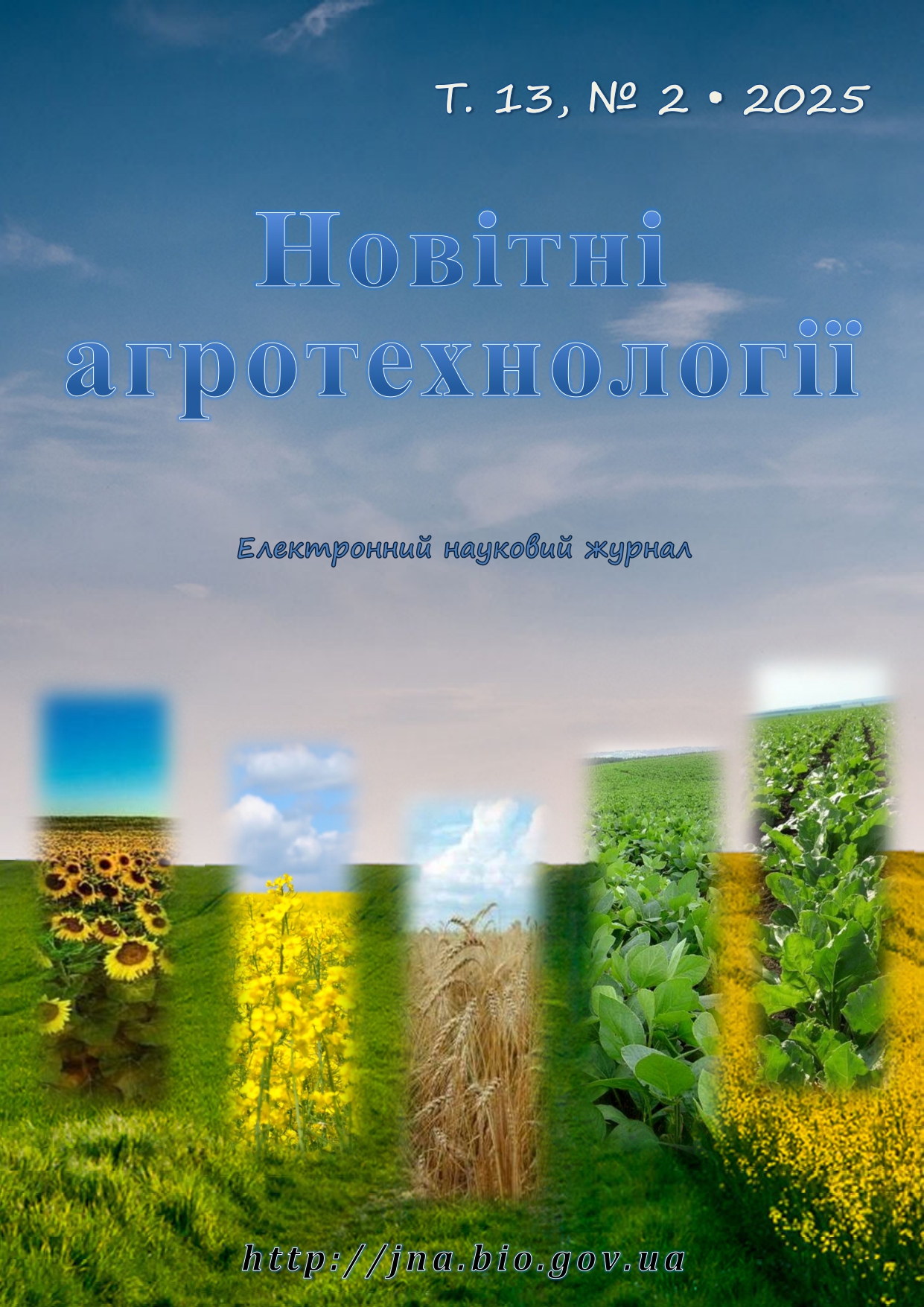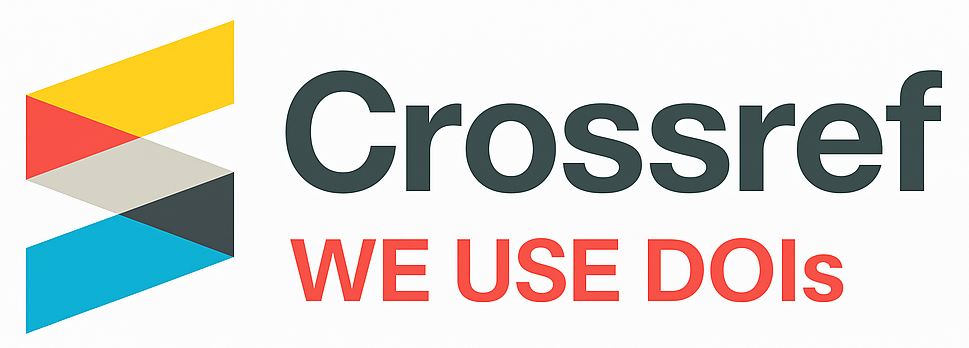Вплив різних норм удобрення на ріст і розвиток Agastache foeniculum (Pursh) Kuntze в умовах Південного Степу України
DOI:
https://doi.org/10.47414/na.13.2.2025.340379Ключові слова:
ефіроолійні рослини, A. foeniculum, вегетативні та генеративні органи, технологія вирощування, ростові процесиАнотація
Мета. Визначити залежність показників росту й розвитку рослин Agastache foeniculum від дози внесення препарату Квантум Діафан (високочисті концентровані композиції макроелементів NPK з комплексом біологічно активних речовин) в умовах Степу Південного. Методи. Досліджували рослини A. foeniculum ‘Лелека’ та ‘Синій велетень’. Використовували польові, лабораторні та вимірювально-вагові методи досліджень. Математичну обробку результатів проводили за програмним забезпеченням Agrostat. Результати. Залежно від норм внесення препарату Квантум Діафан ACTion 10-10-10 висота рослин A. foeniculum першого року розвитку у сорту ‘Лелека’ варіювала від 79,9 до 117,0 см, а у ‘Синій велетень’ від 71,1 до 104,3 см, діаметр кущів від 67,5 до 79,4 см та від 69,0 до 82,6 см відповідно. Залежно від норми внесення препарату рослини сорту ‘Лелека’ мали в середньому 11,9–15,0 пагонів І порядку, довжина яких варіювала від 45,5 до 49,2 см, 27,0–29,8 пагонів ІІ порядку з довжиною 18,0–21,0 см, що дало змогу рослинам сформувати 42,4–46,6 суцвіть. Рослини сорту ‘Синій велетень’ у середньому мали 12,2–15,5 пагонів І порядку із довжиною 47,2–50,0 см, 27,6–31,2 пагонів ІІ порядку із довжиною 17,6–20,0 см, що забезпечило формування 44,0–50,4 суцвіть на кущі. Формування вегетативних та генеративних органів рослин A. foeniculum головним чином залежало від норми внесення препарату (Фактор В), при цьому частка впливу цього фактору в досліді, залежно від визначаємого біометричного показника, становила 56,2–89,0 %. Частка впливу фактору А (сортові особливості) становила 7,5–36,4 %. Висновки. Застосування препарату Квантум Діафан ACTion 10-10-10 за вирощування A. foeniculum в умовах Південного Степу України позитивним чином вплинуло на ріст і розвиток рослин. Найкращі значення біометричних показників вегетативних та генеративних органів рослин отримано за умови внесення препарату із нормою 5,0 л/га, що сприяло збільшенню висоти рослини A. foeniculum сорту ‘Лелека’ на 46,4 %, у ‘Синій велетень’ – на 46,7 %. Під дією препарату відбулося збільшення довжини пагонів І порядку в середньому на 8,1 % та пагонів ІІ порядку на 16,7 % для сорту ‘Лелека’ та на 5,9 і 13,6 % відповідно для ‘Синій велетень’. Подальше збільшення норми внесення препарату призвело до зменшення значень усіх біометричних показників вегетативних та генеративних органів рослин у досліді.
Посилання
Zielińska, S., & Matkowski, A. (2014). Phytochemistry and bioactivity of aromatic and medicinal plants from the genus Agastache (Lamiaceae). Phytochemistry Reviews, 13, 391–416. https://doi.org/10.1007/s11101-014-9349-1
Duda, S. C., Mărghitaş, L. A., Dezmirean, D., Duda, M., Mărgăoan, R., & Bobiş, O. (2015). Changes in major bioactive compounds with antioxidant activity of Agastache foeniculum, Lavandula angustifolia, Melissa officinalis and Nepeta cataria: Effect of harvest time and plant species. Industrial Crops and Products, 77, 499–507. https://doi.org/10.1016/j.indcrop.2015.09.045
Melnychuk, O. A. (2019). Biological and morphological features of plants of the genus Lophanthus Adanson during introduction in the Kremenets Botanical Garden. Plant Introduction, 2, 47–54. http://www.nbg.kiev.ua/upload/introd/Intr-N2-19.pdf#page=47 [In Ukrainian]
Luchian, V., Săvulescu, E., Toma, M., Costache, N., Teodosiu, G., & Popa, V. (2020). Some aspects of the anatomical features of the medicinal plant Agastache foeniculum (Pursh) Kuntze (Lophanthus anisatus (Nutt.) Benth.). Scientific Papers. Series B, Horticulture, LXIV(1), 671–678. https://horticulturejournal.usamv.ro/pdf/2020/issue_1/Art98.pdf
Lashkari, A., Najafi, F., Kavoosi, Gh., & Niazi, S. (2020). Evaluating the in vitro anti-cancer potential of estragole from the essential oil of Agastache foeniculum [Pursh.] Kuntze. Biocatalysis and Agricultural Biotechnology, 27, 101727. https://doi.org/10.1016/j.bcab.2020.101727
Olennikov, D. N., & Kashchenko, N. I. (2024). New acacetin glycosides and other phenolics from Agastache foeniculum and their influence on monoamine oxidase A and B. Applied Biochemistry and Microbiology, 60(4), 663–675. https://doi.org/10.1134/S0003683824604402
Shtereva, L., Vassilevska-Ivanova, R., Stancheva, I., Geneva, M., & Stoyanova, E. (2016). Evaluation of antioxidant activity of Agastache foeniculum and Agastache rugosa extracts. Comptes rendus de l’Académie bulgare des Sciences, 69(3), 295–302. https://www.proceedings.bas.bg/cgi-bin/mitko/0DOC_abs.pl?2016_3_06
Strilbytska, O. M., Zayachkivska, A., Koliada, A., Galeotti, F., Volpi, N., Storey, K. B., Vaiserman, A., & Lushchak, O. (2020). Anise hyssop Agastache foeniculum increases lifespan, stress resistance, and metabolism by affecting free radical processes in Drosophila. Frontiers in Physiology, 11, Article 596729. https://doi.org/10.3389/fphys.2020.596729
Ivanov, I. G., Vrancheva, R. Z., & Petkova, N. T. (2019). Phytochemical compounds of anise hyssop (Agastache foeniculum) and antibacterial, antioxidant, and acetylcholinesterase inhibitory properties of its essential oil. Journal of Applied Pharmaceutical Science, 9(2), 72–78. https://doi.org/10.7324/JAPS.2019.90210
Nourozi, E., Hosseini, B., & Hassani, A. (2014). A reliable and efficient protocol for induction of hairy roots in Agastache foeniculum. Biologia, 69(7), 870–879. https://doi.org/10.2478/s11756-014-0382-8
Ebadollahi, A., Khosravi, R., & Sendi, J. J. (2013). Toxicity and physiological effects of essential oil from Agastache foeniculum (Pursh) Kuntze against Tribolium castaneum Herbst (Coleoptera: Tenebrionidae) larvae. Annual Research & Review in Biology, 3(4), 649–658. https://journalarrb.com/index.php/ARRB/article/view/674
Ebadollahi, A. (2011). Chemical constituents and toxicity of Agastache foeniculum (Pursh) Kuntze essential oil against two stored-product insect pests. University of Toronto. https://utoronto.scholaris.ca/items/f53c16aa-9ab0-433d-9717-8aad15ffcaa0
Vozhehova, R., Svydenko, L., & Valentiuk, N. (2024). Status and prospects of the collection of essential oils and medicinal plants of the Institute of Climate Smart Agriculture. In Ensuring sustainable agricultural production through mitigation and adaptation of global climate changes: International scientific conference (pp. 255–260). Guba, Azerbaijan. [In Ukrainian]
Melnychuk, O. A., & Kubinska, L. A. (2016). Biological features of Lophanthus anisatus Adans in the conditions of the Kremenets Hills of Ukraine. Biological Research: Collected Scientific Papers, 122–124. Ruta. [In Ukrainian]
Kotiuk, L. A., & Svitel’skyi, M. M. (2012). Introduction of promising aromatic plants in Zhytomyr region. In Biodiversity and sustainable development: Proceedings of the scientific-practical conference (pp. 84–85). Simferopol. http://ir.znau.edu.ua/handle/123456789/3653 [In Ukrainian]
Nourozi, E., Hosseini, B., & Hassani, A. (2014). A reliable and efficient protocol for induction of hairy roots in Agastache foeniculum. Biologia, 69(7), 870–879. https://doi.org/10.2478/s11756-014-0382-8
Vârban, R., Vidican, R., Ona, A. D., Vârban, D., Stoie, A., Gâdea, Ștefania, Vâtcă, S., Stoian, V., Crișan, I., & Stoian, V. (2022). Modelling plant morphometric parameters as predictors for successful cultivation of some medicinal Agastache species. Notulae Botanicae Horti Agrobotanici Cluj-Napoca, 50(1), Article 12638. https://doi.org/10.15835/nbha50112638
Omidbaigi, R., & Sefidkon, F. (2004). Effect of sowing time on the essential oil content and composition of Agastache foeniculum. Journal of Essential Oil Bearing Plants, 7(2), 190–194. https://doi.org/10.1080/0972-060X.2004.10643391
Omidbaigi, R., & Mahmoodi, M. (2010). Effect of irrigation regimes on the essential oil content and composition of Agastache foeniculum. Journal of Essential Oil Bearing Plants, 13(1), 59–65. https://doi.org/10.1080/10412905.2014.882274
Talebi, S. F., Saharkhiz, M. J., Kermani, M. J., Sharafi, Y., & Raouf Fard, F. (2017). Effect of different antimitotic agents on polyploid induction of anise hyssop (Agastache foeniculum L.). Caryologia, 70(2), 184–193. https://doi.org/10.17129/botsci.2920
Mahmoodi Sourestani, M., Malekzadeh, M., & Tava, A. (2014). Influence of drying, storage and distillation times on essential oil yield and composition of anise hyssop [Agastache foeniculum (Pursh.) Kuntze]. Journal of Essential Oil Research, 26(3), 177–184. https://doi.org/10.1080/10412905.2014.882274
Khorsandi, O., Hassani, A., Sefidkon, F., Shirzad, H., & Khorsandi, A. (2010). Effect of salinity (NaCl) on growth, yield, essential oil content and composition of Agastache foeniculum Kuntz. Iranian Journal of Medicinal and Aromatic Plants Research, 26(3), 438–451. https://doi.org/10.22092/ijmapr.2010.6807
Kaboudani, M., & Omidbaigi, R. (2009). Effect of different levels of N-fertilizer on the growth, development, essential oil content and compositions of Agastache foeniculum Kuntze. African Journal of Traditional, Complementary and Alternative Medicines, 6, Article 342. https://athmsi.org/journals/index.php/ajtcam/article/view/687
Svydenko, L. V., Hudz, N. I., & Svydenko, A. V. (2023). Results of introduction and breeding of some niche aromatic plants in the Southern Steppe. In Climate-smart agriculture: Science and practice (pp. 225–241). Baltija Publishing. https://doi.org/10.30525/978-9934-26-389-7-12
Svydenko, L. V., & Kremenchuk, R. I. (2015). Status and prospects of collections of new rare subtropical fruit crops, ornamental, aromatic and medicinal plants in southern Ukraine. Plant Genetic Resources, 17, 75–86. [In Ukrainian]
Methodology for examination of plant varieties for distinctness, uniformity and stability (DUS). (2007). Protection of Plant Varieties. Alefa. [In Ukrainian]
Tkachyk, S. O. (Ed.). (2015). Methodology of post-registration study of plant varieties (PRS). Nilan-LTD. [In Ukrainian]
##submission.downloads##
Опубліковано
Як цитувати
Номер
Розділ
Ліцензія
Авторське право (c) 2025 В. М. Свиридовський, Л. В. Свиденко, Т. Ю. Марченко, Н. О. Валентюк

Ця робота ліцензується відповідно до Creative Commons Attribution-ShareAlike 4.0 International License.
"Новітні агротехнології" дотримується авторських прав та дозволів CREATIVE COMMONS для журналів із відкритим доступом.
Автори, які публікуються в цьому журналі, погоджуються з такими умовами:
- автори лишають за собою право на авторство своєї роботи та передають журналу право першої публікації цієї роботи на умовах ліцензії Creative Commons Attribution-ShareAlike 4.0 International License, яка дає змогу іншим особам вільно поширювати опубліковане дослідження з обов'язковим посиланням на авторів оригінальної роботи та першу публікацію роботи в цьому журналі;
- автори мають право укладати самостійні додаткові угоди щодо неексклюзивного розповсюдження роботи такою, якою її було опубліковано цим журналом (наприклад, розміщувати роботу в електронному сховищі установи або публікувати у складі монографії), за умови збереження посилання на першу публікацію роботи в цьому журналі.








